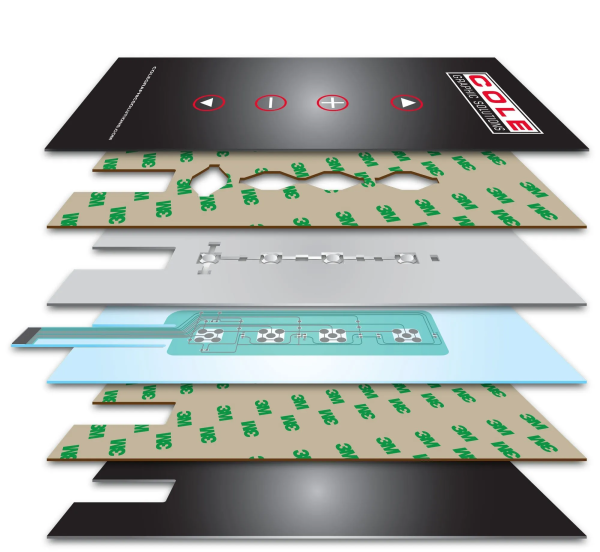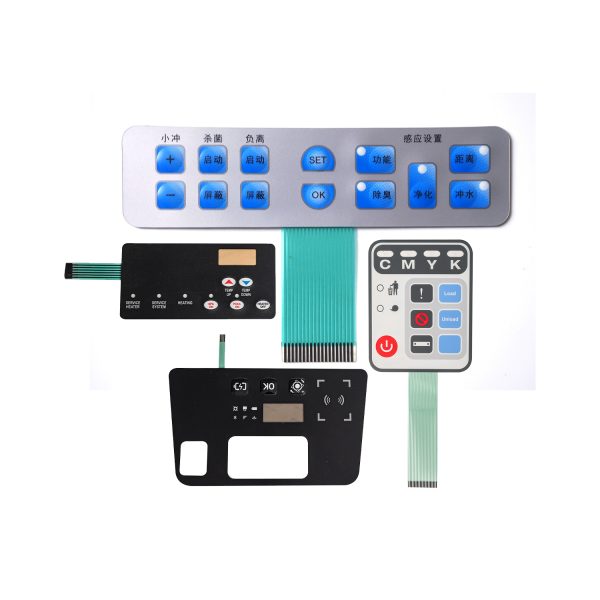What is a “Membrane Switch”?
The membrane switch is an operating system which integrates key function, indicating element and instrument panel.
It consists of four parts: panel, upper circuit, isolation layer and lower circuit. Press the membrane keypad, the contact of the upper circuit deforms downward, and the contact of the plate of the lower circuit is conductive. After the finger is released, the contact of the upper circuit bounces back, the circuit is disconnected, and the loop triggers a signal. Membrane control panel has rigorous structure, good appearance and sealing performance.
It has the characteristics of waterproof and long service life.
Features & Benefits of Membrane Switches Include:
Membrane switch is a new type of electronic key operating system integrating key function, indicator element and instrument panel. Its key features and advantages include:
- Rigorous structure beautiful appearance:
The membrane switch adopts the overall sealing structure composed of plane multi-layer combination, beautiful appearance, good sealing, with waterproof, dust-proof, oil proof, harmful gas erosion and other characteristics.
- Stable and reliable performance:
the contact of the membrane overlay is not easy to be corroded by harmful gases, not easy to oxidize, and has a long service life. At the same time, its performance is stable and reliable, light weight, small size, suitable for use in a variety of environments.
- Rich color, beautiful and generous:
the panel of the membrane switch can be personalized according to the needs of the designer, rich color, good decorative effect, beautiful and generous.
- Easy to operate, quick response:
The operation of the membrane touch switch is very simple, just gently press to turn on the current, release to disconnect the circuit. Each press sends a signal, and the printed circuit board (PCB) controls the specific command.
- Reduce the supporting cost of mechanical and electrical products:
traditional mechanical switches need to be welded during installation, and even need to be matched with a fixed bracket. The installation of the membrane switch is paste type, just remove the back adhesive paper, you can firmly paste on the surface of the whole machine, the lead outlet inserted into the socket of the rear circuit of the whole machine, the circuit can be connected instantly, reducing the supporting cost of mechanical and electrical products.
In summary, with its unique structure and performance advantages, the membrane switch overlay has been widely used in electronic communications, electronic measuring instruments, industrial control, medical equipment, automotive industry, intelligent toys, household appliances and other fields.
How Are Membrane Switches Constructed?
The membrane switch is usually composed of multiple layers, at least 4 layers, up to 9 layers, the specific number of layers will vary due to the design and application. In general, however, the basic structure of the membrane switch panel consists of the following main layers:
Panel layer (graphic overlay), cushion layer, control circuit upper layer (printed circuit), sandwich layer, control circuit lower layer, back layer
When the printed short circuit pad or metal dome makes contact with the bottom circuit layer, the switch activates, closing the circuit.

BX Panel Membrane Switch Technical Information
Structure composition:
The membrane switch is mainly composed of the following layers:
Panel: Usually a plastic (such as polycarbonate PC, polyester PET, etc.) membrane panel, used for decoration and signage, printed with a colorful decorative pattern.
Upper circuit: A circuit layer formed by a conductive material (such as silver paste) printed on a thin membrane for transmitting signals.
Isolation layer: located between the upper circuit and the lower circuit to ensure that the circuit works properly without interfering with each other.
Lower circuit: The circuit layer formed by the conductive material printed on the membrane is also printed, and the circuit is switched on when it is in contact with the upper circuit.
Substrate or backing layer: used to secure and protect the membrane touch overlay.
Some membrane switches may also include additional layers, such as a cushion layer (surface layer) for connecting the panel to the upper circuit, as well as conductive shrapnel.
Working principle:
The working principle of the membrane switch is based on the elastic deformation of the membrane. When the membrane switch is pressed, the contact of the upper circuit will deform downward, and contact the plate of the lower circuit through the isolation layer, so as to achieve the circuit’s conduction. When the finger is released, the upper circuit contact bounces back and the circuit breaks, triggering a signal.
What Special Features Can Be Incorporated into Membrane Switches?
Multiple feedback mechanisms:
Thin flexible membrane switch can provide a variety of feedback mechanisms, such as haptic feedback (touch), sound feedback (such as a buzzer), and visual feedback (such as an LED indicator). These feedback mechanisms can enhance the user experience and give users a more intuitive understanding of the status and operation results of the device.
Lighting Options:
Backlight: This is usually achieved by using a transparent or translucent covering material and positioning LEDs behind the covering to illuminate the switching area.
LED indicator: A single LED can be placed next to or inside the membrane switch housing to provide status indications, such as indicating when a button is pressed or indicating the power status of a device.
EL(electroluminescent) panels: They can be used to backlight thin-membrane switch coverings to provide a uniform light source.
RGB led: RGB(red, green, Blue) LEDs allow for color-changing back-lighting or status indication. They can be controlled individually or in groups to produce different colors and lighting effects.
Touch-sensitive lighting: Some advanced thin LED backlit membrane switch designs incorporate touch sensors that trigger lighting effects when touched. For example, a button may glow when pressed.

Design features of Membrane Switches
The design characteristics of the custom membrane switch are reflected in its compact structure, sensitive trigger, reliable switching function, high customization, good sealing, beautiful appearance and feel, and basic structure. These characteristics make the membrane switch widely used in all walks of life.
What Industries Use Membrane Switches?
Widely used in user interface of electronic communication, electronic measurement instruments, industrial control, medical equipment, automotive industry, intelligent toys, household appliances and other fields.